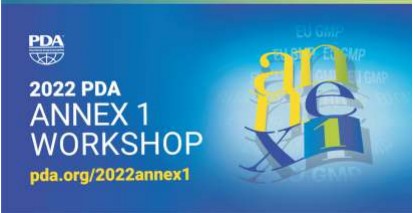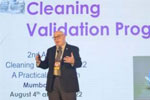PDA’s third Annex 1 Workshop - 6 Key Takeaways

The PDA organized its third workshop from a series of four, that took place in Amsterdam on 22 and 23 September. While Draft Revision 12 of Annex 1 was used for the previous two events in Dallas and Dublin, this time all participants could use the effective version of Annex 1 during the workshop.
The European Medicines Agency was true to its word and the wait is over. While those of the pharmaceutical world involved with the manufacture of sterile products were assessing the text of Draft Revision 12 of the Annex 1, the final approved revision was published on Thursday, 25 August 2022 bringing an end to speculation as to what would be included in the updated Annex.
Similar to the previous workshops, PDA’s Annex 1 event in Amsterdam was characterized by a mix of presentations based on specific Annex 1 topics combined with interactive workshops at which participants had the opportunity to ask the Panel of Experts about the topics on which they presented. Above all, it provided the opportunity to discuss participant’s interpretation, challenges and possible solutions for the compliant implementation of the new Revision to Annex 1 with peers from the industry. This turned out to be very successful based on the number of questions asked during the panel discussions, the high level of interaction with the presenters and engagement at the round-table discussions.
The following 6 Key Takeaways could be extracted from the event:
Implementation Period and Readiness
Following the publication of the final version of Annex 1 companies need to be compliant with the updated Annex’s requirements no later than 25 August 2023, with the exception of the requirement for sterilisation before each load of lyophilizers that are manually loaded and unloaded. Companies are expected to have point 8.123 in operation before 25 August 2024, allowing for an implementation period of two years after publication.
As indicated during the previous PDA Annex 1 workshops by Regulatory representatives, it was not expected that the final text would deviate much from the Revision 12 Draft version published in February 2020. When comparing the final published version with Revision 12 it can indeed be concluded that the body of the text remained unchanged other than the addition of some points of further clarification. Because of this, organisations had the opportunity to start preparing and familiarise themselves over the last two years and knew what was coming. It was one of the reasons the EMA agreed to a deadline of one year for implementation, re-emphasizing that the final published Annex 1 text is based on what regulators already have seen in the industry as a practice and is in essence, not new.
However, it was surprising to hear from the different round-table sessions that there are still organisations where there is limited familiarity with the (Draft) Annex 1 guidance across the company. Feedback was received from multi-site facilities that they expect it will be difficult to implement all requirements within the expected timeframe. For companies availing of Contract Manufacturing Organisations (CMOs), there is an additional challenge as they depend on the readiness and willingness of the CMOs to implement the required changes. This could lead to serious financial costs and time constraints regarding Regulatory approval of an updated Drug Master File (DMF).
Knowing that the clock is ticking and implementation is expected with less than 11 months to go from publication of this Article, companies are urged to familiarise themselves with the final text, perform a Gap Assessment and create a realistic remediation plan with tangible actions to assure compliance from 25 August 2023 onward.
Quality Risk Management (QRM)
As we have seen, QRM applies to the final Annex 1 document in its entirety and not only to specific paragraphs. The expectations are that QRM is to be used in a pro-active scientific approach and data must be present to support the assumptions and decision-making process. QRM is not in place to “risk-out” good practices or expectations, nor to justify bad practices or to justify a predetermined outcome. When correctly used, it shows that an organisation understands their products characteristics, processes to manufacture these products with the facilities and utilities that support these activities. Potential risks are identified and controls are in place to mitigate these risks. The point of a solid Risk Assessment (RA) is to prioritize and action the identified risks. Besides the benefits to the company, it gives Regulators the impression as to how well the organisation understands their process, how they are controlled, and how potential issues are detected.
The maturity of QRM within companies varies, some having Quality Risk Management already embedded in their day-to-day operations while other organisations are exploring how to implement the principles of QRM. It will be challenging for the latter to add a structured formalised Quality Risk Assessment process for areas that were not previously mentioned in Annex 1. Selection of the right Risk Tool is key as it will help to get the right answer. It is often seen that companies default to the tools they are most familiar with, but these are not necessarily the optimum tool. It is like using a hammer to drive in a screw, it could work but it is not ideal. The PDA and American National Standards Institute (ANSI) are collaborating with each other and are soon to present an Aseptic Processing Risk Assessment tool.
Good Quality Risk Assessments are often led by an experienced Risk Facilitator who is familiar with the concepts and can help in the planning of the Quality Risk Assessment, ensuring the scope and Risk Question are fully agreed and documented prior to selection of the most appropriate QRA tool. This person guides the process with a multi-disciplinary team and ensures that the process is kept on track to avoid scope creep. Where the responsibility for ownership lies for completion of risk assessments, who contributes and takes actions can be an equal challenge, potentially leading to delays or even RAs not being completed. For smaller organisations this can be a challenge as it requires support from team members that could be needed elsewhere to keep processes going or to resolve day to day issues. The use of a Responsible Accountable Consulted Informed (RACI)-matrix can provide a solution.
Contamination Control Strategy (CCS)
The requirements for organisations to have their processes and premises designed in such a manner that it minimises the risk for contamination are already laid down in Chapter 3 “Premises and Equipment”, Chapter 5 “Production” and Annex 15 “Qualification and Validation” and date back to 2015. The published Annex 1 re-emphasises these requirements with an expectation that each company has implemented a Contamination Control Strategy (CCS) across their facility with specific focus on microbiological, pyrogen / endotoxin and particulate contamination. It summarizes a minimum of 16 elements to consider when defining and creating a CCS. The document defines all critical control points present with an assessment of their effectiveness. It is a repository of elements and their control measures and evaluates the end-to-end process in a holistic manner to prevent contamination. As the CCS is to be risk-based, CCS and QRM go hand-in-hand and; therefore, are closely related.
The points as described in the QRM section above are also applicable for the development and maintenance of an effective CCS. Often strategy documents describe what an organisation is doing but do not rationalise the “why” as they are too often based on historical undocumented knowledge. The CCS must be based on the outcome of the Quality Risk Assessment process that assess the contamination risks at each point in the process flow.
The CCS must drive continuous improvement and; therefore, must be periodically re-evaluated and adjusted where necessary, particularly when the underpinning Risk Assessment has been revised based on the Change Management and Deviation Processes. Trending of processes, utility and EM data also provide valuable information about the effectiveness of a company’s CCS and warrants periodic revisiting.
For CMO companies and their customers it can be challenging agreeing what information to include in the CCS as some information could be proprietary to the CMO or common across various clients. Risks and proposed mitigation actions or changes are to be communicated to the client hence it is important to understand the risks associated with the process including the API, consumables, and other materials. One solution could be to have one general CCS in place covering the CMO’s overall strategy augmented with a product / process specific CCS. This will enable customers to focus on their product specific elements without the risk of sharing confidential information.
The PDA will soon publish a Technical Report for development of a CCS in pharmaceutical manufacturing to provide guidance as to how to establish such a CCS in an effective manner.
Pre Use Post Sterilisation Integrity Testing (PUPSIT)
It is not surprising that PUPSIT remained a highly debated topic during the PDA Annex 1 Workshop in Amsterdam. Although the FDA Regulators are not enforcing PUPSIT, it will be the norm in the EU and outside. There will be situations where PUPSIT can be omitted such as small volume radio-actives, but these have to be rigorously scientifically justified with supporting data. Defining a rationale for not performing PUPSIT will be very difficult and it could be a major compliance issue for companies who, to date, have not considered integration of PUPSIT in their final sterile filtration process.
For processes that use Single Use Systems (SUS) it is expected that the CCS is designed in such a way that it allows for PUPSIT. Early engagement with the SUS supplier is paramount to ensure the system is designed correctly and they are capable of meeting the supply demand from a quality and quantity perspective.
Interestingly, the PDA performed masking test studies and demonstrated that some products are fouling and can clog damaged filters leading to a passing Post-Use Filter Integrity Test. This strengthens the position of the Regulators that it reduces the risk of using a non-integral filter going undetected when using PUPSIT. As a former Regulator rightfully commented: It is not the question “how can we avoid PUPSIT?”, there should be a mindset of “How can we implement PUPSIT”.
Container Closure Integrity Testing (CCIT)
When comparing the Draft Revision 12 as published in February 2020 with the effective revision of Annex 1 there is one adjustment regarding the requirement for 100% CCIT of units that are closed by fusion. While the Draft revision required containers of all volumes be subjected to a 100% integrity test using a validated method, this has now changed to containers up to a volume of 100mL. For larger volumes the test frequency may be reduced and if so, it must be scientifically justified and based on data. However, one must keep in mind that it is more important to focus on a robust process with adequate controls in place to prevent container closure integrity failures rather than defining a test strategy that confirms compliance of the product but doesn’t actually control the level of failure.
For units sealed by stopper / seals, integrity testing must be performed using a validated method as visual inspection alone is not deemed sufficient. Apart from the initial validation and as part of product stability testing, not all companies perform routine CCIT on filled units. There are different technologies available that could be introduced inline / online such as oxygen headspace measurement, vacuum leak tests, high voltage tests and residual seal force measurement to name a few. There is no “silver bullet” or “one-size-fits-all” solution and organisations are advised to seek support from expert companies. Like any other sampling program, the frequency must be based on risk and statistically justified. A life-cycle approach for vial/ stopper filling seems to be the practice that is accepted.
CCIT verification must be part of transportation as transport conditions such as decompression can lead to movement of plungers in pre-filled syringes. Temperature fluctuations can affect integrity issues as experienced during the challenges with -80°C transport and storage conditions of the mRNA COVID vaccines.
Premises and Barrier Systems
Removing personnel from the open aseptic process is the most effective way to reduce the risk of introducing contamination caused by humans. This can be achieved by introducing a physical barrier between the critical Grade A zone in the form of Restricted Access Barrier Systems (RABS) or using isolator technology. Hence the published Annex 1 puts a firm recommendation in place to consider the use of barrier technology.
Organisations must understand that there are significant differences in barrier technologies and their associated controls. For example, utilising a RABS system whereby doors are frequently opened to perform inherent or corrective interventions are not deemed appropriate for RABS but are considered a classic Grade A/B design as it does not segregate operator interference from the critical zone during interventions. This was already spelled out in USP <1116> “Microbiological Control and Monitoring of Aseptic Processing Environments”.
Regarding the use of isolator technology, while the previous Annex 1 revision from 2009 required a minimum classification of Grade D as background for isolators there are now further expectations. A Grade D background is allowed when using a closed isolator system, i.e. there is no infeed from or outfeeds to a lower classified area. The product including all primary packaging components is present in the isolator and the entire aseptic process is completed including sealing of the final product container within the isolator before opening the isolator again.
Open isolators are configurations where, for example, containers are transferred through a depyrogenation tunnel oven into the critical Grade A zone, units are filled and moved out of the Isolator via a mousehole. These require at minimum a Grade C background and this must be justified in the CCS.
When a product requires lyophilization, the design of the loading and unloading process plays an important factor as it will dictate the sterilisation frequency of the Lyophiliser Chamber. As per point 8.123, manually loaded and unloaded lyophilisation processes without barrier technology require sterilisation of the Lyophiliser Chamber before each load. Companies have two years from the date of publication to comply with this requirement and this could have implications for an organisation’s manufacturing capacity and, as a result, potential effect on market supply.
Retrofitting existing lyophilisation set-ups can be a challenge, with the financial burden being only one aspect. In collaboration with Engineering Specialists, a workable solution must be found that allows for automatic loading and unloading of the current configuration or implementation of barrier technology. The available footprint can be a restricting factor, not to mention the delivery time for a re-engineered process and qualification and validation of the new process. These could easily exceed the allowed grace period of two years.
Summary
With the final text published on 25 August 2022 time is ticking for organisations to have the guidance in operation no later than 25 August 23. With less than 11 months to go, companies must ensure they know the implications of the published version. A structured Gap Assessment and realistic remediation plan to address any non-compliances in a timely manner is important to satisfy Regulatory inspections and future-proof the Company’s compliance with Annex 1. This requires in-depth knowledge of one’s manufacturing process and identification of associated risks augmented with remediation actions when it comes to correct adoption and successful implementation of Quality Risk Management.
The final published version calls on organisations to adopt a new mindset that goes top-down, is holistic and may ask for cultural changes. It is expected that considerations are given to novel technologies such as deployment of barrier technology, online Container Closure Integrity Testing and rapid / alternative monitoring methods. All with the purpose to improve product quality and, ultimately, patient safety.








